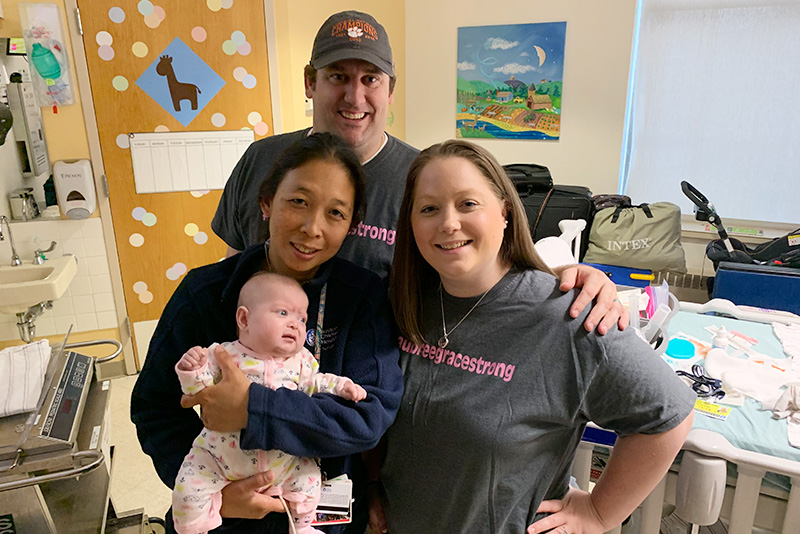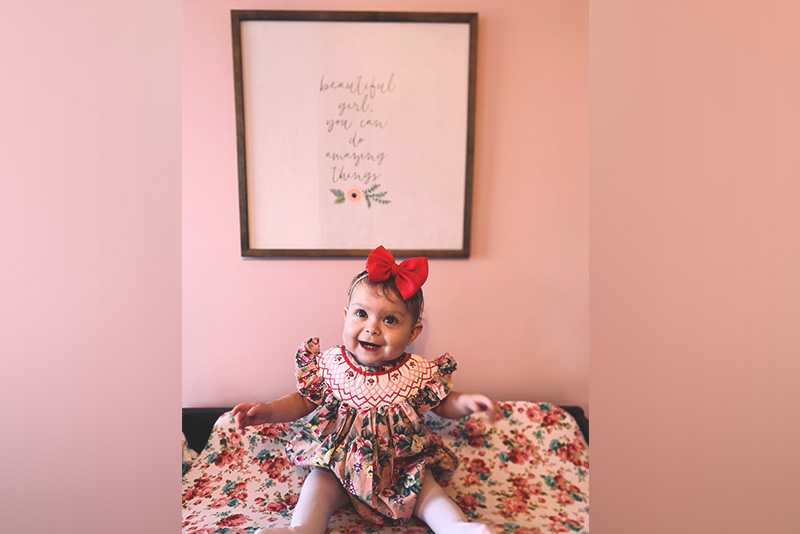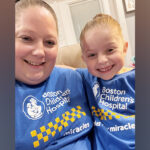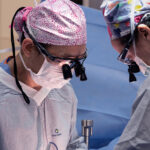Answers for Aubree: Finding support for OEIS

Michelle and Stephen Strickland are used to having questions about their infant daughter, Aubree’s, health. After all, Aubree was born last year with a rare and complex condition called cloacal exstrophy, or OEIS syndrome, in which many of the internal abdominal structures and organs are exposed outside the body. OEIS can include an omphalocele, rectal and bladder exstrophy, imperforate anus, and spinal defects. It’s a condition that few clinicians are familiar with or comfortable treating.
So it came as a surprise when, after being referred from their home hospital in South Carolina to Dr. Belinda Dickie, Michelle quickly received a personal email from the surgeon. Dr. Dickie, director of the Colorectal and Pelvic Malformation Center at Boston Children’s Hospital, “immediately put me at ease,” says Michelle. “She told us not to worry and that she was excited to meet Aubree and care for her.”

A long road ahead
Still, the family knew that Aubree would have a long road ahead of her. She remained in her local neonatal intensive care unit (NICU) for two and half months until she had grown enough to undergo surgery. After a “crazy few days” of securing transportation to Boston and nearby housing, it was finally time for Aubree’s next procedure. “When we left South Carolina for Boston, we had no idea how long we would be gone,” says Michelle. In total, their daughter spent 138 days in the hospital.
It was an unfamiliar experience for these first-time parents. Although Aubree had been diagnosed prenatally with an omphalocele and neural tube defect, it came as a complete shock when she was born that there was much more involved and that she in fact had OEIS. Given the initial diagnosis, Michelle and Stephen had some time to prepare and adjust to the idea of an extended NICU stay and surgery. “But we didn’t have any experience with extended hospital stays,” Michelle admits. The new diagnosis took them down a road they hadn’t planned for and “it took a while to fully grasp that and settle into our new normal.”

Making connections
Their adjustment to Boston was made easier by the welcoming nature of the clinical team. Michelle and Stephen had barely set their bags down when Dr. Dickie arrived at Aubree’s bedside. “We had questions no one else had been able to answer, but she sat with us for almost an hour, explaining everything and getting to know us,” says Michelle. “We could tell from day one how invested she is in Aubree.” The family also got to know the center’s social worker Matt Tvedte and registered nurse Paula Cruz, who help guide them through Aubree’s care.
The family has made other connections, too. They’ve stayed in touch with a family whose daughter was also in the NICU, and have become close with another family whose daughter also has OEIS and is seen at Boston Children’s. “It’s so amazing how much better you feel having someone to talk to who knows exactly what you are going through,” says Michelle.

A whole team of support for OEIS
Now 16 months old, Aubree is “blowing us away developmentally,” says Michelle. A ball of energy and sass, she loves books, music, toys with different textures, and her family’s four cats. “She’s so curious and definitely has ‘FOMO’ (fear of missing out) — she likes meeting people, especially other babies.”
Meanwhile, Aubree and her parents are continuing along her OEIS journey, with possible future procedures by Dr. Joseph Borer and Dr. Dickie, as well as neurosurgeons in South Carolina. But they know that they have a whole team behind them. “When you hear how rare this condition is, you expect to feel really alone,” says Michelle. “But we don’t feel that way at all. The support we’ve received has been phenomenal.”
Learn about the Colorectal and Pelvic Malformation Center.
Related Posts :
-

Hard and beautiful at the same time: Five lessons of raising a medically complex child
When they learned they were expecting a baby, Michelle and Stephen Strickland were delighted. The South Carolina couple looked forward ...
-

‘Supported and heard’: Harven gets care for an anorectal malformation
Like lots of 3-year-olds, Harven Gifford has a great imagination. Lately, he’s taken to roaring loudly and pretending that ...
-

Surgery beats sclerotherapy for rectal prolapse in children ages 5 and older
Rectal prolapse — the protrusion of the lining of a child’s rectum through the anal sphincter — can occur for many ...
-

‘A picture-perfect life’: Makayla is thriving with OEIS syndrome
On a sunny day this spring, Makayla Brisson was on a mission: to find the two bunny rabbit sculptures in ...





